Proper Youth Batting Stance How To Improve Power For Baseball & Softball 2022 | Best Open, Square, Closed, Wide, Elbow Up Or Down Hitting Tips
Baseball Batting Stance That Will Reduce Strikeouts?
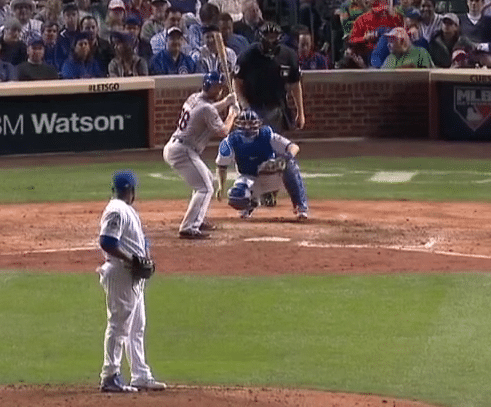
2015 Daniel Murphy in triple flexion (hip, knees, and ankles). Photo courtesy: MLB.com
This post will discuss the proper youth batting stance and how to improve power for both baseball and softball in 2022. Best open, square, closed, and wide stance information in addition to whether to keep the back elbow up or down hitting tips.
The baseball batting stance video post was sparked by my friend, whom I admire and respect as a man AND hitting instructor, doing great work in the San Diego-California area, Ryan Lehr (@thepureswingsd).
He’s worked under the hitting tutelage of Reggie Smith for over 15 years, and really has a fantastic grasp of the absolutes to the swing.
For those of you who don’t know Reggie Smith’s teachings, he’s as much of a ‘science-guy’ as we are.
And yes, this works for fastpitch softball as well as baseball.
The point of this video post, is to look at being in an athletic baseball batting stance and its effect on reducing strikeouts.
We’ll be looking at:
- Effective baseball batting stance context,
- Metrics of low-strikeout high-ISO hitters, and
- Which low-K% high-ISO MLB hitters to model?
Effective Baseball Batting Stance Context
Easier to Hit Difficult Pitches
At Ryan Lehr & Reggie Smith’s Christmas hitting clinic, Kevin Sweeney talked about how getting more athletic in his baseball batting stance allowed him to hit difficult pitches…
Mike Sweeney talking about how he became great. Stopped standing tall, & got in an athletic position! pic.twitter.com/la5njg4wVG
— Ryan Lehr (@thepureswingsd) December 21, 2015
Making Adjustments to Gravitational Forces
Taylor Gardner, founder of the Backspin Batting Tee, says that a first baseman stretches toward the thrown ball when receiving it. Knees are bent and the eyes are getting on level plane with thrown ball and receiving glove.
Gravitational Forces are acting on the ball at ALL times.
Here’s something that may piss off some fastpitch softball pitching coaches and pitchers…
Taylor Gardner came to the conclusion that a ‘rise-ball’ is a myth. And I AGREE!
And if you don’t believe us:
- Find your fastest fastpitch softball pitcher,
- Video record her throwing a ‘rise-ball’ from the side angle where you get her and the catcher in the same frame, and
- Track the trajectory of the ball’s flight to the catcher’s glove on slo-mo software…
I guarantee the apex of the pitched ball’s arc will be above where it’s caught by the catcher.
It’s because of GRAVITY!!!
Sure the arc will be less, the harder the pitcher throws, but there will still be an arc nonetheless.
Who Else Gets into an Athletic Position?
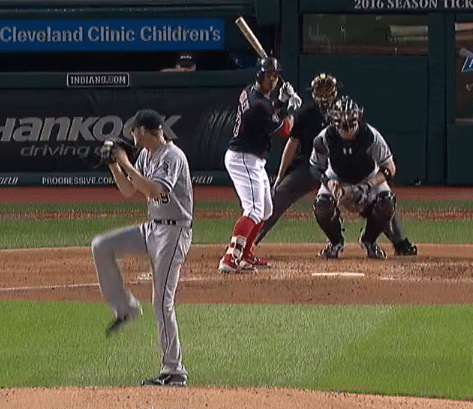
2015 Michael Brantley in triple flexion. Photo courtesy: MLB.com
I ask my players what knee position they’d start in if they were:
- Defending against a quickly advancing soccer striker,
- Defending a fast wide receiver five-yards off the line,
- The only one between a breakaway power forward and the hoop in basketball,
- Going to throw a 16-pound Shot Put as far as humanly possible, or
- Receiving a blazing serve from Roger Federer?
CLICK HERE for Speed Coach Lee Taft (@LeeTaft) blog post on why bending the knees is important to force production.
I alluded to the ‘triple flexion’ baseball batting stance in this video post breaking down Joey Votto’s swing.
Votto has one of the best swings to model if you want to cut down on ground-balls, strikeouts, weak fly balls, and just want to get on base more and make more frequent solid contact. He’s the ultimate Pitch-Plane Dominator!
Metrics of Low-Strikeout High-ISO Hitters
I wanted to compare the Strikeout Percentage and ISO metrics to see if we could find a correlation between the baseball batting stance and hitters who rarely strikeout, but also maintain some element of power.
One of the biggest MYTHS is that you can only be a contact hitter, or a power hitter. And that you can’t be both. Nowadays, SABERmetric people conclude that when homers go up, so does the rise of strikeouts.
My belief is there CAN BE more going on between the numbers…
When looking back in time, we saw quite a few examples of fusing minimal strikeouts and raw power…Hank Aaron, Ted Williams, Joe Dimaggio, and Babe Ruth to name a few.
Okay, so what is ISO? Isolated Power, according to FanGraphs.com basically describes a hitters “raw power”.
For you SABR wannabe math nerds (like me!), here’s a simple formula to compute ISO in two different ways:
- ISO = SLG minus AVG, OR
- ISO = Extra Bases divided by At-Bats
Here’s an excel spreadsheet I put together, using FanGraph.com’s metrics, on the top-5 highest and lowest strikeout percentages among 2015 hitters, their ISO’s, and dinger totals:
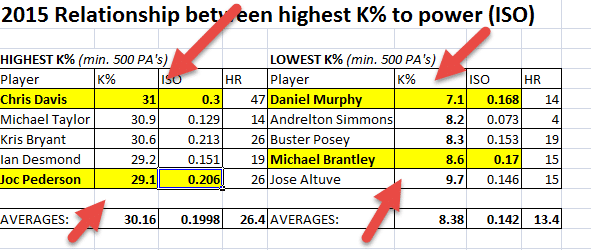
We analyze the highlighted hitters in the above video. Daniel Murphy and Michael Brantley having virtually above average ISO’s…
Compare how these hitters rank for K%:
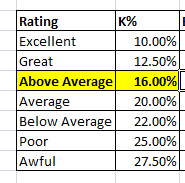
According to Fangraphs.com
Compare how these hitters stack up for ISO:

According to FanGraphs.com
What’s plain as day is how ‘awful’ the top-5 highest K% are. Eee-gads! Not even trying there 😛
The silver lining though, is that there are a couple top-5 lowest K% that have virtually above average ISO’s, and one I’m excited to see perform in 2016 with a change in his baseball batting stance toward the end of the 2015 season…
Which Low Strikeout MLB Hitters to Model?
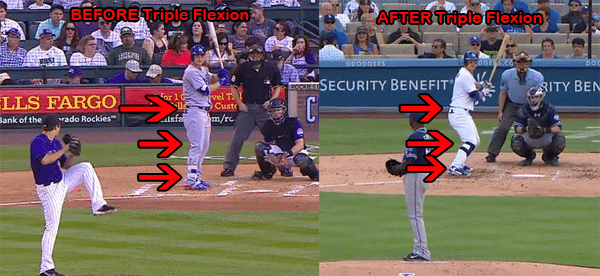
Notice Joc Pederson baseball batting stance change – left image is halfway through 2015 & right image is at the end of 2015. Photo courtesy: MLB.com
As Tony Robbins says, “Success leaves clues”. He also said,
“If you want to be successful, find someone who has achieved the results you want and copy what they do and you’ll achieve the same results.”
If you’re the coach (or hitter) who’s goal it is to reduce strikeouts among your hitters, while also preserving some elements of power, whose swing should you model?
…At least from a baseball batting stance point of view?
After analyzing the metrics, my answer’s are:
- Daniel Murphy,
- Michael Brantley, and
- Joc Pederson (the end of 2015 baseball batting stance version).
Watch the video above for more in-depth analysis of these hitters.
I’m not sure how many strikeouts Joc Pederson had without ‘triple flexion’ in 2015 versus with it, but I’m anticipating way less strikeouts for him in 2016 if he keeps this principle in his baseball batting stance. He’s a special hitter, and not a very big slugger (6’1″, 215-pounds).
Also, I know that correlation may not equal causation in this case, but it’s worth looking into. So I’d love your thoughts and analysis on other low K% hitters with above average ISO’s…
To be continued… 😉
- Fix Late Swings Fast: 2025 Pitch Recognition & See-Decide-Swing Training for Youth Baseball Power Hitters - October 6, 2025
- Safe Youth Weighted Bat Training: Proven Overload/Underload Drills to Increase Exit Velocity in Games Starting Tonight - September 29, 2025
- AI Coaching Course 2025: Youth Baseball & Softball Practice Plan + Off-Season & In-Season Workout Builder Fast - September 23, 2025

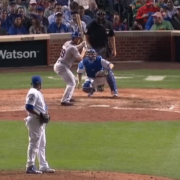
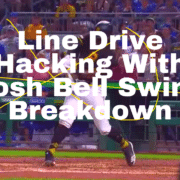





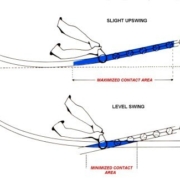




Joey,
If you sign up on the Englishbey Hitting site,you could enhance your knowledge 10 fold.You like the science and you try hard which is a good combination. You are in a position in terms of knowledge where Steve was about a decade or so ago so there is not much sense in your trying to reinvent the wheel .
One quick example would be your discussion of the rise ball and the fact that it doesn’t rise. About 10 years a guy named Scott Sarginson showed that video you described from the side . Sarah Pauly was the pitcher and he(SARGE) did the video with the pitchers father.Of course you are right that the ball doesn’t rise but you are reinventing the wheel in the same fashion as when you are talking about the stance of hitters and the value of an athletic stance.Have you seen the way Manny set up? Did he have strike out issues?
As far as contact goes, your stance means a lot. If your a guy who bends alot at the knees, has low hands at launch and tilts the spine, you better lay off the high pitches. I have not seen a hitter with those three traits that can hit waist high fastballs.
On the other hand, guys that have vertical spine angles and high hands and less knee bend usually hit higher pitches better.
Trout:
High hands at launch
Lots of Spine Tilt
= bad high fastball hitter
Granderson:
Low hands
Lots of spine tilt
bent knees
= even worse high fastball hitter
Pujols:
High Hands
No spine tilt (vertical back)
bent knees
= great high fastball hitter
Chris Davis:
Low hands at launch
Some Spine tilt
slightly bent knees
= bad high fastball hitter
Ricky Henderson:
Medium Hands
Tons of spine tilt
Lots of knee bend
= horrible high fastball hitter
Don Mattingly:
Fairly Low Hands
Tons of spine tilt
Medium knee bend
= below average high fastball hitter
Kyle, great breakdown! I know we talked about a few of these hitters in a past post, but it’s awesome to get other examples and see the relationships between batting stance and hand positioning that can be a strength, but also a weakness in the swing. Bravo!
Statistical evidence can be contaminated in baseball hitting by other factors as well, which makes them even harder to analyze. For instance … Does the player take a lot of called strikes? Does he swing at pitches out of the strike zone? If a player gets frozen on two strikes (routinely takes the first pitch even if it’s a juicey one), or swings at pitches in the dirt … his strike out rate will look worse. Coaching, attitude, etc have a lot to do with that type of strike out.
Right on Bob! I knew when writing this post that I was using a loose interpretation. But I wanted to open Pandora’s Box and see what was inside. I totally agree with though.
Larry what are doing? To start if a video 10 years ago explained something point, does that mean that said point should not be made again…I realized that the ball doesn’t rise when I was 8…That doesn’t mean that others have realized it or it’s not a good teaching idea…
Reinventing the wheel! Really! Are suggesting Englishbey invented all what he teaches… To start I seen some of Englishbey teaching and I don’t agree with all he teaches but that besides the point. Also Some people known about the rising ball years ago and even decades ago…I’ve been following Joey for awhile now and Joey does a real great job on teaching and informing the public about the baseball swing…Joey opens the door to discussion and learning… Plugging another name and downplaying the teachings in this video does nothing to add to the discussion. Reinventing the wheel!!! Are you serious!!!! I say we only talk baseball and if you can’t add to the discussion, than what are doing here?
Really? Joey puts out some great videos and his work is greatly appreciated…Stop attacking and plugging others and just add to the discussion…By the way I don’t know Joey at all, I’ve just learned lots by his teachings especially how to teach or how to go about communicating the particulars of the swing… Thanks for the video Joey. Remember most of us appreciate you hard work…~DM
Djura, thanks for your support. I was going to respond to Larry, but you put into words what I was going to say. It’s very rare to find anything original nowadays. Most of what we learn has been re-packaged from others. I’ll be the first to admit, my strength isn’t originality, it’s repurposing content. What’s wrong with standing on the shoulders of giants? The truth will come out in analyzing different hitters, comparing their metrics, and seeing if the aggregate of information tells the real story. Manny Ramirez stood taller, and according to FanGraphs (http://gohpl.com/1Pn32cu) had an average K% of 18.5% over 20 years. That puts him between ‘average’ and ‘above average’ on the K% rating chart. His over 20-year average ISO is .273…amazing! He’s above ‘excellent’ on the ISO ranking chart. Like with everything in this world, there will surely be exceptions to the rule. But what I’m interested in are what kind of patterns the numbers reveal to us. Does how a player stands in the box affect his/her strikeouts? Batting average? Fly-ball/line-drive/ground-ball percentages? We have enough metrics, technology, and access to smart people out there, let’s find answers, and not smother creativity.
Joey I think that approach is excellent!!! For me the physics or science (how the body moves) has taken over but “could” lead people to the wrong conclusions… As a side note, we all need to know the physics and the baseball but knowing how to hit the ball as far as possible doesn’t mean we should do it… I think that it’s time for the baseball people and science people to now include the mathematicians when it pertains to the baseball swing… By that I mean probabilities…. What approach gives us the best probabilities for success…and I bet asking that question could lead us to a better approach but now we will have to deal with the older baseball people along with the physics people…
And looking at patterns is the start of investigating the math “probability” of the baseball swing… In some sense people do this already… For example, swing at a pitch you can hit… Another way of saying increase your probability of hitting… I think it’s best to figure out how to square a ball than figure out how to drive it…again perhaps a different way of looking at the same thing….Later. ~DM
Great observation Djura! The more I look at hitting, the more it becomes a group effort by ALL disciplines: math, physics, psychology, biomechanics, engineering, biology, chemistry (nutrition), etc. The Japanese seemed to have controlled the math variable. They aren’t as obsessed with power like we are here. Their focus seems to be on harmony and balance. But I may be wrong. As always, thanks for sharing!